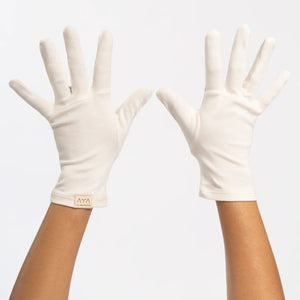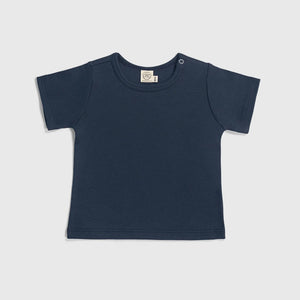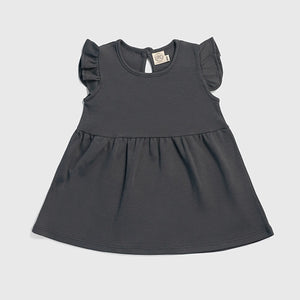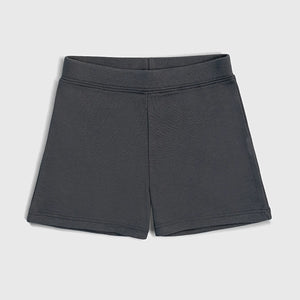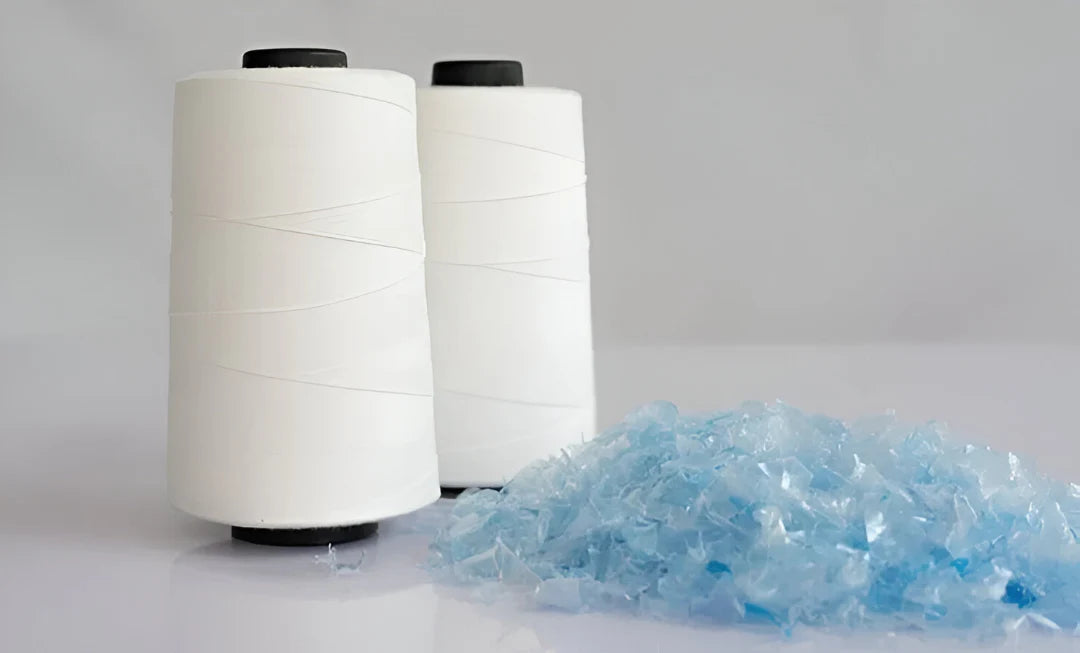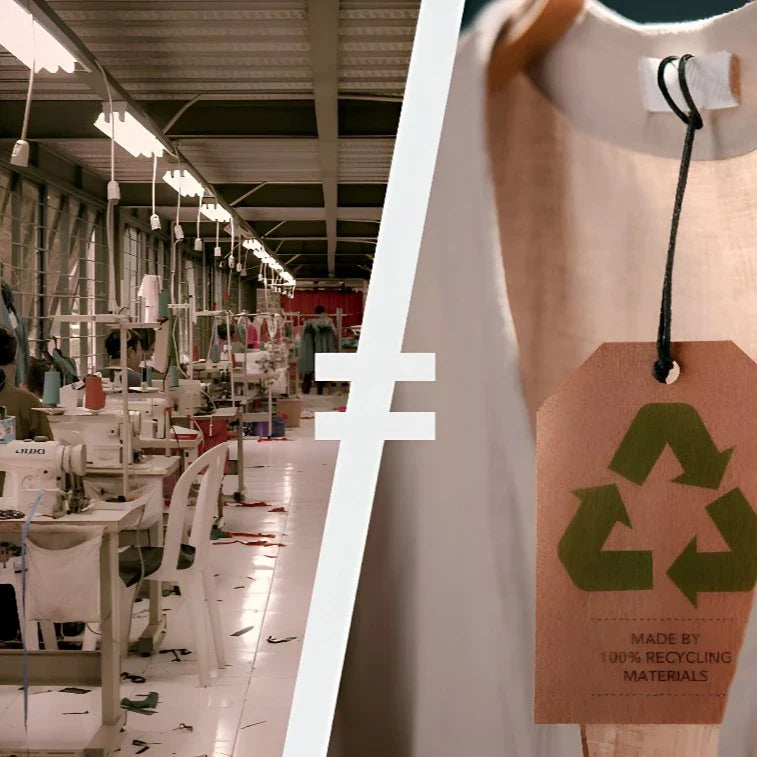Zero Waste Day: The Urgent Fight Against Fast Fashion’s Destruction
.
AYA | MARCH 28, 2025
READING TIME: 5 minutes
By Jordy Munarriz & Lesia Tello
AYA | MARCH 28, 2025
READING TIME: 5 minutes
By Jordy Munarriz & Lesia Tello
On Zero Waste Day, we must confront this harsh reality and demand a transformative overhaul of the textile supply chain. This article will critically examine the multifaceted waste footprint of fashion, highlighting the urgent need for systemic change.
The Unforgiving Scale of Textile Waste
The numbers are staggering. Global textile waste now exceeds 90–95 million tons annually—a figure that continues to rise as fast fashion fuels a "throwaway culture" [1]. Every step in the textile supply chain, from raw material extraction to post-consumer disposal, adds layers of waste and environmental impact. Landfills are overflowing with discarded clothing, and as these textiles decompose, they emit methane and other potent greenhouse gases that accelerate climate change [2,3]. Meanwhile, synthetic garments shed microplastics that persist for centuries, with studies suggesting that 35% of the microplastics in our oceans come from the textile industry [3].
The cumulative result is an industry that not only squanders precious resources but also inflicts long-term damage on ecosystems and communities worldwide.

A clothing landfill on a public street in one of the countries where clothing manufacturing is outsourced.
Waste Generation Throughout the Textile Supply Chain
Raw Material Extraction and Manufacturing: A Critical Look
Traditional agricultural practices for producing plant-based fibers guzzle enormous amounts of water, chemicals, and energy. Meanwhile, harvesting animal fibers consumes vast quantities of water, and the waste from livestock releases potent greenhouse gases like methane. Synthetic fibers aren’t any better: their production involves high-energy chemical treatments that generate hazardous waste [3].
For instance, textile and dyeing industries along China's coastal regions account for over 50% of all such facilities—remember, giants like H&M and SHEIN have production plants there. Shockingly, wet processing techniques—washing, dyeing, sizing, and softening—require between 50 to 150 liters of water per kilogram of textile material [4]. This makes the textile industry one of the most detrimental to global water quality. The effluents from these plants carry toxic compounds that directly or indirectly infiltrate aquatic ecosystems, eventually leading to soil degradation in water bodies and a severe loss of biodiversity [4]. This is not just unsustainable—it's an environmental crisis.
Post-Consumer Waste: An Urgent Issue
Fast fashion’s relentless turnover has fostered a "throwaway culture" [5]. Out of more than 90 million tons of textile waste generated annually worldwide [1,3,6,7], only 1% is recycled [5,6,7], and in the EU—despite having some of the best recycling programs on the planet—87% of this waste ends up incinerated or in landfills [6,8].
Market giants are heavily criticized for their role in this crisis. Shein, for example, produces up to 10,000 new designs a day [10]. This staggering output is fundamentally incompatible with sustainable objectives. Even H&M, which recently inked a $600 million, 7-year contract to secure recycled polyester production [8], will never truly offset the harmful environmental legacy left behind by fast fashion.
Similarly, second-hand markets—both online and in brick-and-mortar stores—have surged in popularity. According to a recent ThredUp report, the second-hand market is projected to double within the next five years and reach $900 million by 2035 [11], as consumers increasingly choose pre-owned clothing to lower their environmental footprint.
In short, conventional advertising by major brands often downplays the waste problem to meet economic targets, instead pushing "sustainable collections" that merely disguise the inherent inefficiencies in their supply chains—what is known as greenwashing [12]. This discrepancy forces us to ask a hard question: how much of what we see in ads is genuine, and how much is simply a smokescreen to divert attention from the colossal waste crisis within the fashion industry?

SHEIN clothing distribution centers. One of hundreds in China alone.
Recycling and Sustainable Production Innovations
Innovative breakthroughs in material extraction—from organic farming techniques to biotechnology and AI-driven manufacturing—are finally forcing the fashion industry to confront its waste crisis. Advanced production methods now incorporate digital textile printing, which can save up to 65% energy, 40% dye, and 66% water consumption, with 92% of the water being recyclable and reusable [13]. Furthermore, the dye transfer and fixation rate of 95% is maintained [13].
Automated sorting systems employing optical sensors and machine learning algorithms have revolutionized recycling [14,15], boosting the recovery of high-quality fibers from mixed-material garments by nearly 50% compared to traditional methods [16]. This isn’t just about efficiency—it's about unlocking new revenue streams by reclaiming valuable post-consumer materials.
Packaging remains another critical front. A study of 400 international clothing brands found that 57% have made clear progress in sustainable packaging, 34% have begun transitioning to improved solutions, and only a small fraction are planning radical redesigns [17]. Innovations such as smart packaging, which tracks the product lifecycle and provides data for recycling [18,19], are also being adopted, optimizing delivery times and resources and reducing the ecological footprint of products.

Biodegradable bags free of synthetic plastics.
Sustainability Standards and Policy Barriers in Fashion Waste Reduction
Modern frameworks like GRI [20], ESG [21], and IFRS S1/S2 [22,23] offer a powerful opportunity for the textile industry. When brands disclose their sustainability metrics under these standards, they reveal crucial data on water usage, chemical inputs, and waste management. This transparency not only attracts eco-conscious consumers—willing to pay more for ethical products—but also draws sustainable investment, which has surged by over 25% in just two years [24,25].
Yet, political barriers and regulatory inconsistencies hold the industry back. In the US, environmental rules for fashion are increasingly set by private standards instead of robust public policy—a legacy of deregulation and withdrawal from global agreements like the Paris Agreement [26,27]. Similar challenges persist worldwide. In Europe, despite ambitious plans to recycle 65% of municipal waste by 2035, enforcement remains weak, while emerging economies struggle with under-resourced policy frameworks [28,29].
Changing Demographics and Preferences
The pandemic also highlighted shifting demographics in the fashion market. Younger consumers, particularly Gen Z and Millennials, became increasingly influential in shaping purchasing trends. Research from the Institute for Sustainable Fashion indicates that younger generations are more likely to support sustainable brands, with 83% of Millennials stating they prefer to buy from companies that share their values [7,8].
Moreover, with the rise of remote work, many consumers reported a preference for comfort over style. A study published in the Journal of Fashion Marketing and Management noted that comfort became the primary driver of clothing purchases for many consumers, with 65% prioritizing comfort in their buying decisions [9]. This trend is likely to persist as remote work becomes a more permanent aspect of many industries.

Changing Demographics and Preferences
The pandemic also highlighted shifting demographics in the fashion market. Younger consumers, particularly Gen Z and Millennials, became increasingly influential in shaping purchasing trends. Research from the Institute for Sustainable Fashion indicates that younger generations are more likely to support sustainable brands, with 83% of Millennials stating they prefer to buy from companies that share their values [7,8].
Moreover, with the rise of remote work, many consumers reported a preference for comfort over style. A study published in the Journal of Fashion Marketing and Management noted that comfort became the primary driver of clothing purchases for many consumers, with 65% prioritizing comfort in their buying decisions [9]. This trend is likely to persist as remote work becomes a more permanent aspect of many industries.

Changing Demographics and Preferences
The pandemic also highlighted shifting demographics in the fashion market. Younger consumers, particularly Gen Z and Millennials, became increasingly influential in shaping purchasing trends. Research from the Institute for Sustainable Fashion indicates that younger generations are more likely to support sustainable brands, with 83% of Millennials stating they prefer to buy from companies that share their values [7,8].
Moreover, with the rise of remote work, many consumers reported a preference for comfort over style. A study published in the Journal of Fashion Marketing and Management noted that comfort became the primary driver of clothing purchases for many consumers, with 65% prioritizing comfort in their buying decisions [9]. This trend is likely to persist as remote work becomes a more permanent aspect of many industries.

Changing Demographics and Preferences
The pandemic also highlighted shifting demographics in the fashion market. Younger consumers, particularly Gen Z and Millennials, became increasingly influential in shaping purchasing trends. Research from the Institute for Sustainable Fashion indicates that younger generations are more likely to support sustainable brands, with 83% of Millennials stating they prefer to buy from companies that share their values [7,8].
Moreover, with the rise of remote work, many consumers reported a preference for comfort over style. A study published in the Journal of Fashion Marketing and Management noted that comfort became the primary driver of clothing purchases for many consumers, with 65% prioritizing comfort in their buying decisions [9]. This trend is likely to persist as remote work becomes a more permanent aspect of many industries.


Signing of the US withdrawal from the Paris agreement - Trump
This stark reality fuels massive waste throughout the supply chain, leaving only a fraction of the industry truly sustainable. The gap between rising eco-conscious purchasing—a 45% increase globally [30]—and sluggish regulatory action is alarming. The fashion industry must adopt and enforce these sustainability standards now, and a movement that is now part of the global environmental calendar is pursuing these goals: Zero Waste Day.
Zero Waste Day: A Global Catalyst for Hope and Change
Zero Waste Day isn’t just a symbolic event—it’s a searing indictment of decades of environmental neglect and overproduction in the fashion industry.
Pioneering Initiatives and Milestones
In 2001, California set a precedent by establishing ambitious waste reduction targets, demonstrating that governmental policies could drive significant environmental improvements. The following year, San Francisco launched a comprehensive Zero Waste program, achieving an 80% waste diversion rate by 2010 through stringent recycling and compulsory composting measures [31]. These actions served as global models for waste reduction strategies.
The movement gained international recognition in 2022 when the United Nations proclaimed March 30 as International Zero Waste Day [32], marking a collective commitment to reduce waste, promote circular economies, and enforce stricter environmental standards.
Global Impact and Future Directions
The inaugural celebration of Zero Waste Day in 2023 ignited global action. In Japan, the town of Kamikatsu became a beacon of sustainable waste management by recycling 80% of its waste and striving for 100% Zero Waste [33,34]. South Korea implemented a mandatory food waste composting system, successfully reducing food waste by 95% [35,36], showcasing the potential for similar approaches in textile waste management.
In 2025, the VII International Circular Economy Meeting in Gipuzkoa convened over 40 experts to discuss strategies, including the use of artificial intelligence, to optimize resource use and minimize waste [37]. Cities like Copenhagen and Taipei are piloting "Zero Waste City" initiatives, integrating recycling, composting, and sustainable urban planning to dramatically reduce urban waste [38].
The Zero Waste International Alliance is developing a strategic global roadmap for Zero Waste 2050 [32,39], outlining concrete actions across multiple sectors to achieve near-zero waste through technological innovation, policy reform, and community engagement.
These examples compel us to question the narrative pushed by fast fashion and scrutinize the true environmental cost of our everyday choices. The time for complacency has passed; immediate, decisive action is imperative to combat the escalating waste crisis.

Segregation and recycling plant in the city of Kamikatsu - Japan.
Final Reflection: The Time for Radical Change Is Now
Zero Waste Day is a powerful call for radical change in our production and consumption patterns. As consumers, we must demand transparency from the fashion industry and support initiatives that truly reduce waste and conserve our precious resources.
At AYA, we didn't stop at being 100% organic fiber and completely plastic-free—we constantly innovate in accessories and natural dyes, reinventing ourselves. We believe there's always room to be more sustainable. The era of complacency is over; immediate and decisive action is imperative to combat the growing waste crisis.
Will we continue to turn a blind eye to the waste and destruction of fast fashion, or are we finally ready to confront the brutal truth of our unsustainable consumption?

Glossarykeywords
Automated Sorting Systems:
They are machines that quickly and accurately separate and sort shipments. They are used in the postal sector, e-commerce, warehouses, and express sorting systems.
Digital Textile Printing:
This is a method of printing on fabric using inkjet technology.
Effluents:
They are wastes that are released into water or air, such as sewage or smoke.
Environmental Footprint:
It measures the impact of human activities on the planet. It considers the amount of natural resources consumed and the amount of waste generated.
ESG:
ESG stands for Environmental, Social and Governance. It is a set of criteria that evaluate a company's impact on the environment, society, and its transparency. Unlike GRI standards, ESG is more closely tied to a company's financial situation.
GRI:
It is an organization that establishes an international standard for companies to report their economic, social, and environmental impact. It developed a series of standards (the GRI standards) so that any organization, large or small, private or public, can prepare a report based on comparable and verifiable data.
IFRS S1/S2:
IFRS S1 and S2 are international standards that establish how companies should report their financial information related to governance, strategy, risk management, and sustainability goals (in the case of IFRS S1 and S2), and related to climate protection (in the case of IFRS S2).
Landfills:
A landfill is a place where waste is disposed of on land. Landfills are the oldest and most common form of waste disposal. Today, landfills have been established exclusively for textile waste.
Microplastics:
Microplastics are small plastic pieces less than five millimeters long which can be harmful to our ocean and aquatic life.
Packaging:
A container or wrapper that temporarily holds products, used in the retail industry as a protective layer for products.
Polyester:
It's a synthetic fiber used as a fabric in the textile industry to create garments and all types of clothing. Its versatility and adaptability to different dyeing processes make it ideal for the fast fashion process.
Secondhand Market:
This is a place to buy and sell used items, such as clothing, electronics, and household goods. Secondhand markets include stores, online marketplaces, and flea markets.
Sustainable Collections:
In the fashion world, they refer to clothing lines made with sustainable materials or processes that seek to achieve a standard of sustainability.
The International Day of Zero Waste:
It is celebrated annually on March 30. The day's goal is to promote sustainable consumption and production and raise awareness about zero-waste initiatives.
Throwaway Culture:
This subculture of purchasing behavior is the practice of discarding something after a single use. It can also include things that end up in landfills after a few days or weeks of use.
Traditional Agricultural Practices:
These are agricultural methods that utilize natural resources, organic fertilizers, and indigenous knowledge. These practices are often passed down from generation to generation, without regard for sustainability measures.
Authors & Researchers

Jordy Munarriz
Environmental Engineer with a master's degree in renewable energy and a specialization in sustainability. Researcher and writer, he combines his technical knowledge with his passion for environmental communication, addressing topics of ecological impact and sustainable solutions in the textile industry and beyond.

Lesia Tello
Biologist and researcher specializing in biochemistry, with a master’s degree in education. Passionate about scientific inquiry, she explores the complexities of life and the processes that sustain it. Her work focuses on the intersection of science, education, and communication, making scientific knowledge accessible and impactful.
Authors & Researchers
Authors & Researchers


Jordy Munarriz
Environmental Engineer with a master's degree in renewable energy and a specialization in sustainability. Researcher and writer, he combines his technical knowledge with his passion for environmental communication, addressing topics of ecological impact and sustainable solutions in the textile industry and beyond.
Lesia Tello
Biologist and researcher specializing in biochemistry, with a master’s degree in education. Passionate about scientific inquiry, she explores the complexities of life and the processes that sustain it. Her work focuses on the intersection of science, education, and communication, making scientific knowledge accessible and impactful.
References:
[1] Global Fashion Group. GFG People-Planet-Positive Report 2022 [Internet]. 2022 [cited 2025 Mar 27].
[2] Textile Exchange. Preferred Fibers and Materials Definitions Guidance [Internet]. Jan 2023 [cited 2025 Mar 28].
[3] Ellen MacArthur Foundation. A New Textiles Economy [Internet]. 2025 [cited 2025 Mar 28]. Available from: https://www.ellenmacarthurfoundation.org/a-new-textiles-economy
[4] Li F, Guo Z, Mao L, Feng J, Huang J, Tao H. Impact of Textile Industries on Surface Water Contamination by Sb and Other Potential Toxic Elements: A Case Study in Taihu Lake Basin, China. Int J Environ Res Public Health. 2023 Feb 17;20(4):3600. doi: 10.3390/ijerph20043600.
[5] United Nations Environment Programme. Moving throwaway culture [Internet]. [cited 2025 Mar 28]. Available from: https://www.unep.org/cep/news/speech/moving-throwaway-culture
[6] Global Standard. Wet Processing [Internet]. 2025 [cited 2025 Mar 28]. A
[7] European Parliament. The impact of textile production and waste on the environment: Infographics [Internet]. 2020 Dec 8 [cited 2025 Mar 28]. Available from: https://www.europarl.europa.eu/topics/en/article/20201208STO93327/the-impact-of-textile-production-and-waste-on-the-environment-infographics
[8] McKinsey & Company. State of Fashion [Internet]. 2023 [cited 2025 Mar 28]. Available from: https://www.mckinsey.com/industries/retail/our-insights/state-of-fashion
[9] Moazzem S, Wang L, Daver F, Crossin E. Environmental impact of discarded apparel landfilling and recycling. Resour Conserv Recycl. 2021 Mar;166:105338. doi: 10.1016/j.resconrec.2020.105338
[10] McKinsey & Company. What is fast fashion? [Internet]. New York: McKinsey & Company; 2024 [cited 2025 Mar 28].
[11] ThredUp. ThredUp 2023 Resale Report [Internet]. 2023 [cited 2025 Mar 28].
[12] Nguyen HN. Fast Fashion & Greenwashing: The worst combination for Sustainability [dissertation]. Messina: Università degli Studi di Messina, Department of Economics, Master’s Degree in International Management; 2023.
[13] Khalil E, Sarkar J, Rahman MM, Shamsuzzaman M, Das D. Innovative Textile Printing Technology. In: Advanced Technology in Textiles. June 2023;139-159. doi:10.1007/978-981-99-2142-3_5.
[14] Dodampegama S, Hou L, Asadi E, Zhang G, Setunge S. Revolutionizing construction and demolition waste sorting: Insights from artificial intelligence and robotic applications. Resour Conserv Recycl. 2024 Mar;202:107375. doi:10.1016/j.resconrec.2023.107375
[15] Kroell N, Chen X, Greiff K, Feil A. Optical sensors and machine learning algorithms in sensor-based material flow characterization for mechanical recycling processes: A systematic literature review [Internet]. Waste Manag. 2022 Jul 15;149:259-290. Available from: https://doi.org/10.1016/j.wasman.2022.05.015
[16] Cura K, Rintala N, Kamppuri T, Saarimäki E, Heikkilä P. Textile Recognition and Sorting for Recycling at an Automated Line Using Near Infrared Spectroscopy. Recycling [Internet]. 2021;6(1):11. doi:10.3390/recycling6010011
[17] Jestratijevic I, Vrabič-Brodnjak U. Sustainable and innovative packaging solutions in the fashion industry: global report [Internet]. Sustainability; 2022 Oct 19;14(20):13476. [cited 2025 Mar 28]. Available from: https://doi.org/10.3390/su142013476
[18] Piparsaniya K, Tandur S. Eco-Friendly Packaging in Fashion and Retail: Aligning Style With Sustainability. In: Sustainable Practices in the Fashion and Retail Industry. ©2025;28. doi:10.4018/979-8-3693-9959-0.ch009
[19] Ekon. Smart Packaging: Marcas inteligentes [Internet]. n.d. [cited 2025 Mar 28].
[20] Global Reporting Initiative. GRI Standards: Sustainability Reporting Guidelines [Internet]. 2023 [cited 2025 Mar 28]. Available from: https://www.globalreporting.org
[21] International Organization for Standardization. Climate Change & ESG Reporting [Internet]. Geneva: ISO; [cited 2025 Mar 28]. Available from: https://www.iso.org/climate-change/esg-reporting
[22] International Financial Reporting Standards Foundation. IFRS S1 General Requirements [Internet]. London: IFRS Foundation; 2022 [cited 2025 Mar 28]. Available from: https://www.ifrs.org/issued-standards/ifrs-sustainability-standards-navigator/ifrs-s1-general-requirements/
[23] International Financial Reporting Standards Foundation. IFRS S2: Climate-related Disclosures [Internet]. IFRS Foundation; n.d. [cited 2025 Mar 28]. Available from: https://www.ifrs.org/issued-standards/ifrs-sustainability-standards-navigator/ifrs-s2-climate-related-disclosures/
[24] Harvard Business Review. ESG Investing Isn't Designed to Save the Planet [Internet]. 2022 Aug [cited 2025 Mar 28]. Available from: https://hbr.org/2022/08/esg-investing-isnt-designed-to-save-the-planet
[25] Bloomberg. Global ESG assets predicted to hit $40 trillion by 2030 despite challenging environment forecasts: Bloomberg Intelligence [Internet]. New York: Bloomberg; 2023 [cited 2025 Mar 28].
[26] European Parliamentary Research Service. Circular economy in fashion: Policy challenges and opportunities [Internet]. 2025 [cited 2025 Mar 28]. Available from: https://www.europarl.europa.eu/thinktank/en/document/EPRS_ATA(2025)767230
[27] CarbonFact. US Regulations for Fashion Brands [Internet]. 2024 [cited 2025 Mar 28].
[28] European Commission. Circular Economy Action Plan [Internet]. Brussels: European Commission; [cited 2025 Mar 28]. Available from: https://environment.ec.europa.eu/strategy/circular-economy-action-plan_en
[29] United Nations Environment Programme. Sustainability and Circularity in the Textile Value Chain: A Global Roadmap [Internet]. European Commission; 2023 [cited 2025 Mar 28].
[30] Business Dasher. Environmentally conscious consumers statistics [Internet]. n.d. [cited 2025 Mar 28]. Available from: https://www.businessdasher.com/environmentally-conscious-consumers-statistics/
[31] U.S. Environmental Protection Agency. Case Study: San Francisco [Internet]. EPA: Transforming Waste Tool; 2025 [cited 2025 Mar 28].
[32] United Nations. Zero Waste Day [Internet]. New York: United Nations; [cited 2025 Mar 28].
[33] Washington Post. Japan zero-carbon village climate [Internet]. 2022 [cited 2025 Mar 28]. Available from: https://www.washingtonpost.com/climate-solutions/interactive/2022/japan-zero-carbon-village-climate/
[34] Nippon.com. Guide to Japan [Internet]. Nippon.com; n.d. [cited 2025 Mar 28].
[35] The Guardian. South Korea zero food waste composting system [Internet]. 2022 Nov 20 [cited 2025 Mar 28]. Available from: https://www.theguardian.com/environment/2022/nov/20/south-korea-zero-food-waste-composting-system
[36] Anadolu Agency. How South Korea won the battle against food waste [Internet]. Ankara: Anadolu Agency; 2023 [cited 2025 Mar 28].
[37] Gipuzkoa. Gipuzkoa Ekonomia Zirkularraren Abangoardian: Nazioarteko 40 aditu baino gehiagorekin [Internet]. Gipuzkoa: Gobierno Vasco; n.d. [cited 2025 Mar 28]. Available from: https://www.gipuzkoa.eus/es/-/gipuzkoa-ekonomia-zirkularraren-abangoardian-nazioarteko-40-aditu-baino-gehiagorekin
[38] Asian Development Bank. Green Cities [Internet]. Manila: Asian Development Bank; 2010 [cited 2025 Mar 28]. Available from: https://www.adb.org/sites/default/files/publication/30059/green-cities.pdf
[39] United Nations Development Programme. Zero Waste Offer [Internet]. New York: UNDP; [cited 2025 Mar 27]. Available from: https://www.undp.org/chemicals-waste/our-work/zero-waste-offer
Glossarykeywords
Bamboo:
The term "bamboo fabric" generally refers to a variety of textiles made from the bamboo plant. Most bamboo fabric produced worldwide is bamboo viscose, which is economical to produce, although it has environmental drawbacks and poses occupational hazards.
Cellulose Nanocrystals (CNCs):
They are rod-shaped nanoparticles derived from cellulose. They are biodegradable and renewable materials used in various fields, such as construction, medicine, and crude oil separation.
Circularity in the Textile Value Chain:
It seeks to design durable, recyclable, and long-lasting textiles. The goal is to create a closed-loop system where products are reused and reincorporated into production.
Cotton:
A soft white fibrous substance that surrounds the seeds of a tropical and subtropical plant and is used as textile fiber and thread for sewing.
Fertilizers:
These are nutrient-rich substances used to improve soil characteristics for better crop development. They may contain chemical additives, although there are new developments in the use of organic substances in their production.
Jute:
It is a fiber derived from the jute plant. This plant is composed of long, soft, and lustrous plant fibers that can be spun into thick, strong threads. These fibers are often used to make burlap, a thick, inexpensive material used for bags, sacks, and other industrial purposes. However, jute is a more refined version of burlap, with a softer texture and a more polished appearance.
Hemp:
Industrial hemp is used to make clothing fibers. It is the product of cultivating one of the subspecies of the hemp plant for industrial purposes.
Linen:
It is a plant fiber that comes from the plant of the same name. It is very durable and absorbent, and dries faster than cotton. Thanks to these properties, it is comfortable to wear in warm climates and is valued for making clothing.
Organic Cotton:
It is grown with natural seeds, sustainable irrigation methods, and no pesticides or other harmful chemicals are used in its cultivation. As a result, organic cotton is presented as a healthier alternative for the skin.
Pesticides:
It is a substance used to control, eliminate, repel, or prevent pests. Industry uses chemical pesticides for economic reasons.
Subsidy:
It can be defined as any government assistance or incentive, in cash or kind, towards private sectors - producers or consumers - for which the Government does not receive equivalent compensation in return.
The International Day of Zero Waste:
It is celebrated annually on March 30. The day's goal is to promote sustainable consumption and production and raise awareness about zero-waste initiatives.
UNEP:
The United Nations Environment Programme is responsible for coordinating responses to environmental problems within the United Nations system.
Water-Intensive Practices:
These are activities that consume large amounts of water. These practices can have significant environmental impacts, especially in water-scarce regions.
World Water Day:
It is an international celebration of awareness in the care and preservation of water that has been celebrated annually on March 22 since 1993.
Glossarykeywords
Automated Sorting Systems:
They are machines that quickly and accurately separate and sort shipments. They are used in the postal sector, e-commerce, warehouses, and express sorting systems.
Digital Textile Printing:
This is a method of printing on fabric using inkjet technology.
Effluents:
They are wastes that are released into water or air, such as sewage or smoke.
Environmental Footprint:
It measures the impact of human activities on the planet. It considers the amount of natural resources consumed and the amount of waste generated.
ESG:
ESG stands for Environmental, Social and Governance. It is a set of criteria that evaluate a company's impact on the environment, society, and its transparency. Unlike GRI standards, ESG is more closely tied to a company's financial situation.
GRI:
It is an organization that establishes an international standard for companies to report their economic, social, and environmental impact. It developed a series of standards (the GRI standards) so that any organization, large or small, private or public, can prepare a report based on comparable and verifiable data.
IFRS S1/S2:
IFRS S1 and S2 are international standards that establish how companies should report their financial information related to governance, strategy, risk management, and sustainability goals (in the case of IFRS S1 and S2), and related to climate protection (in the case of IFRS S2).
Landfills:
A landfill is a place where waste is disposed of on land. Landfills are the oldest and most common form of waste disposal. Today, landfills have been established exclusively for textile waste.
Microplastics:
Microplastics are small plastic pieces less than five millimeters long which can be harmful to our ocean and aquatic life.
Packaging:
A container or wrapper that temporarily holds products, used in the retail industry as a protective layer for products.
Polyester:
It's a synthetic fiber used as a fabric in the textile industry to create garments and all types of clothing. Its versatility and adaptability to different dyeing processes make it ideal for the fast fashion process.
Secondhand Market:
This is a place to buy and sell used items, such as clothing, electronics, and household goods. Secondhand markets include stores, online marketplaces, and flea markets.
Sustainable Collections:
In the fashion world, they refer to clothing lines made with sustainable materials or processes that seek to achieve a standard of sustainability.
The International Day of Zero Waste:
It is celebrated annually on March 30. The day's goal is to promote sustainable consumption and production and raise awareness about zero-waste initiatives.
Throwaway Culture:
This subculture of purchasing behavior is the practice of discarding something after a single use. It can also include things that end up in landfills after a few days or weeks of use.
Traditional Agricultural Practices:
These are agricultural methods that utilize natural resources, organic fertilizers, and indigenous knowledge. These practices are often passed down from generation to generation, without regard for sustainability measures.
Glossarykeywords
Air Dye:
A waterless dyeing technology that uses air to apply color to textiles, eliminating wastewater and reducing chemical use.
Automation in Textile Production:
The use of AI, robotics, and machine learning to improve efficiency, reduce waste, and lower production costs in the fashion industry.
Carbon Emissions:
Greenhouse gases, particularly carbon dioxide (CO₂), released by industrial processes, transportation, and manufacturing, contributing to climate change.
Circular Economy:
A production and consumption model that minimizes waste and maximizes resource efficiency by designing products for durability, reuse, repair, and recycling.
CO₂ Dyeing (DyeCoo):
A sustainable dyeing technology that uses pressurized carbon dioxide instead of water, significantly reducing water waste and pollution.
Ethical Fashion:
Clothing produced in a way that considers the welfare of workers, animals, and the environment, ensuring fair wages and responsible sourcing.
Fast Fashion:
A mass production model that delivers low-cost, trend-based clothing at high speed, often leading to waste, environmental pollution, and unethical labor practices.
GOTS (Global Organic Textile Standard):
A leading certification for organic textiles that ensures responsible farming practices, sustainable processing, and fair labor conditions.
Greenwashing:
A misleading marketing strategy used by companies to appear more environmentally friendly than they actually are, often exaggerating sustainability claims.
Nanobubble Technology:
A textile treatment method that applies chemicals and dyes using microscopic bubbles, reducing water and chemical usage.
Natural Dyes:
Dyes derived from plants, minerals, or insects that are biodegradable and free from toxic chemicals, unlike synthetic dyes.
Ozone Washing:
A low-impact textile treatment that uses ozone gas instead of chemicals and water to bleach or fade denim, reducing pollution and water consumption.
Proximity Manufacturing:
The practice of producing garments close to consumer markets, reducing transportation-related carbon emissions and promoting local economies.
Recycled Polyester (rPET):
Polyester made from post-consumer plastic waste (e.g., bottles), reducing dependence on virgin petroleum-based fibers.
Slow Fashion:
A movement opposing fast fashion, focusing on sustainable, high-quality, and ethically made clothing that lasts longer.
Sustainable Fashion:
Clothing designed and manufactured with minimal environmental and social impact, using eco-friendly materials and ethical labor practices.
Upcycling:
The creative reuse of materials or textiles to create new products of equal or higher value, reducing waste without breaking down fibers.
Wastewater Recycling:
The treatment and reuse of water in textile production, minimizing freshwater consumption and reducing pollution.
Zero-Waste Design:
A fashion design approach that maximizes fabric efficiency, ensuring that no textile scraps go to waste during the cutting and sewing process.
References:
[1] Global Fashion Group. GFG People-Planet-Positive Report 2022 [Internet]. 2022 [cited 2025 Mar 27].
[2] Textile Exchange. Preferred Fibers and Materials Definitions Guidance [Internet]. Jan 2023 [cited 2025 Mar 28].
[3] Ellen MacArthur Foundation. A New Textiles Economy [Internet]. 2025 [cited 2025 Mar 28]. Available from: https://www.ellenmacarthurfoundation.org/a-new-textiles-economy
[4] Li F, Guo Z, Mao L, Feng J, Huang J, Tao H. Impact of Textile Industries on Surface Water Contamination by Sb and Other Potential Toxic Elements: A Case Study in Taihu Lake Basin, China. Int J Environ Res Public Health. 2023 Feb 17;20(4):3600. doi: 10.3390/ijerph20043600.
[5] United Nations Environment Programme. Moving throwaway culture [Internet]. [cited 2025 Mar 28]. Available from: https://www.unep.org/cep/news/speech/moving-throwaway-culture
[6] Global Standard. Wet Processing [Internet]. 2025 [cited 2025 Mar 28]. A
[7] European Parliament. The impact of textile production and waste on the environment: Infographics [Internet]. 2020 Dec 8 [cited 2025 Mar 28]. Available from: https://www.europarl.europa.eu/topics/en/article/20201208STO93327/the-impact-of-textile-production-and-waste-on-the-environment-infographics
[8] McKinsey & Company. State of Fashion [Internet]. 2023 [cited 2025 Mar 28]. Available from: https://www.mckinsey.com/industries/retail/our-insights/state-of-fashion
[9] Moazzem S, Wang L, Daver F, Crossin E. Environmental impact of discarded apparel landfilling and recycling. Resour Conserv Recycl. 2021 Mar;166:105338. doi: 10.1016/j.resconrec.2020.105338
[10] McKinsey & Company. What is fast fashion? [Internet]. New York: McKinsey & Company; 2024 [cited 2025 Mar 28].
[11] ThredUp. ThredUp 2023 Resale Report [Internet]. 2023 [cited 2025 Mar 28].
[12] Nguyen HN. Fast Fashion & Greenwashing: The worst combination for Sustainability [dissertation]. Messina: Università degli Studi di Messina, Department of Economics, Master’s Degree in International Management; 2023.
[13] Khalil E, Sarkar J, Rahman MM, Shamsuzzaman M, Das D. Innovative Textile Printing Technology. In: Advanced Technology in Textiles. June 2023;139-159. doi:10.1007/978-981-99-2142-3_5.
[14] Dodampegama S, Hou L, Asadi E, Zhang G, Setunge S. Revolutionizing construction and demolition waste sorting: Insights from artificial intelligence and robotic applications. Resour Conserv Recycl. 2024 Mar;202:107375. doi:10.1016/j.resconrec.2023.107375
[15] Kroell N, Chen X, Greiff K, Feil A. Optical sensors and machine learning algorithms in sensor-based material flow characterization for mechanical recycling processes: A systematic literature review [Internet]. Waste Manag. 2022 Jul 15;149:259-290. Available from: https://doi.org/10.1016/j.wasman.2022.05.015
[16] Cura K, Rintala N, Kamppuri T, Saarimäki E, Heikkilä P. Textile Recognition and Sorting for Recycling at an Automated Line Using Near Infrared Spectroscopy. Recycling [Internet]. 2021;6(1):11. doi:10.3390/recycling6010011
[17] Jestratijevic I, Vrabič-Brodnjak U. Sustainable and innovative packaging solutions in the fashion industry: global report [Internet]. Sustainability; 2022 Oct 19;14(20):13476. [cited 2025 Mar 28]. Available from: https://doi.org/10.3390/su142013476
[18] Piparsaniya K, Tandur S. Eco-Friendly Packaging in Fashion and Retail: Aligning Style With Sustainability. In: Sustainable Practices in the Fashion and Retail Industry. ©2025;28. doi:10.4018/979-8-3693-9959-0.ch009
[19] Ekon. Smart Packaging: Marcas inteligentes [Internet]. n.d. [cited 2025 Mar 28].
[20] Global Reporting Initiative. GRI Standards: Sustainability Reporting Guidelines [Internet]. 2023 [cited 2025 Mar 28]. Available from: https://www.globalreporting.org
[21] International Organization for Standardization. Climate Change & ESG Reporting [Internet]. Geneva: ISO; [cited 2025 Mar 28]. Available from: https://www.iso.org/climate-change/esg-reporting
[22] International Financial Reporting Standards Foundation. IFRS S1 General Requirements [Internet]. London: IFRS Foundation; 2022 [cited 2025 Mar 28]. Available from: https://www.ifrs.org/issued-standards/ifrs-sustainability-standards-navigator/ifrs-s1-general-requirements/
[23] International Financial Reporting Standards Foundation. IFRS S2: Climate-related Disclosures [Internet]. IFRS Foundation; n.d. [cited 2025 Mar 28]. Available from: https://www.ifrs.org/issued-standards/ifrs-sustainability-standards-navigator/ifrs-s2-climate-related-disclosures/
[24] Harvard Business Review. ESG Investing Isn't Designed to Save the Planet [Internet]. 2022 Aug [cited 2025 Mar 28]. Available from: https://hbr.org/2022/08/esg-investing-isnt-designed-to-save-the-planet
[25] Bloomberg. Global ESG assets predicted to hit $40 trillion by 2030 despite challenging environment forecasts: Bloomberg Intelligence [Internet]. New York: Bloomberg; 2023 [cited 2025 Mar 28].
[26] European Parliamentary Research Service. Circular economy in fashion: Policy challenges and opportunities [Internet]. 2025 [cited 2025 Mar 28]. Available from: https://www.europarl.europa.eu/thinktank/en/document/EPRS_ATA(2025)767230
[27] CarbonFact. US Regulations for Fashion Brands [Internet]. 2024 [cited 2025 Mar 28].
[28] European Commission. Circular Economy Action Plan [Internet]. Brussels: European Commission; [cited 2025 Mar 28]. Available from: https://environment.ec.europa.eu/strategy/circular-economy-action-plan_en
[29] United Nations Environment Programme. Sustainability and Circularity in the Textile Value Chain: A Global Roadmap [Internet]. European Commission; 2023 [cited 2025 Mar 28].
[30] Business Dasher. Environmentally conscious consumers statistics [Internet]. n.d. [cited 2025 Mar 28]. Available from: https://www.businessdasher.com/environmentally-conscious-consumers-statistics/
[31] U.S. Environmental Protection Agency. Case Study: San Francisco [Internet]. EPA: Transforming Waste Tool; 2025 [cited 2025 Mar 28].
[32] United Nations. Zero Waste Day [Internet]. New York: United Nations; [cited 2025 Mar 28].
[33] Washington Post. Japan zero-carbon village climate [Internet]. 2022 [cited 2025 Mar 28]. Available from: https://www.washingtonpost.com/climate-solutions/interactive/2022/japan-zero-carbon-village-climate/
[34] Nippon.com. Guide to Japan [Internet]. Nippon.com; n.d. [cited 2025 Mar 28].
[35] The Guardian. South Korea zero food waste composting system [Internet]. 2022 Nov 20 [cited 2025 Mar 28]. Available from: https://www.theguardian.com/environment/2022/nov/20/south-korea-zero-food-waste-composting-system
[36] Anadolu Agency. How South Korea won the battle against food waste [Internet]. Ankara: Anadolu Agency; 2023 [cited 2025 Mar 28].
[37] Gipuzkoa. Gipuzkoa Ekonomia Zirkularraren Abangoardian: Nazioarteko 40 aditu baino gehiagorekin [Internet]. Gipuzkoa: Gobierno Vasco; n.d. [cited 2025 Mar 28]. Available from: https://www.gipuzkoa.eus/es/-/gipuzkoa-ekonomia-zirkularraren-abangoardian-nazioarteko-40-aditu-baino-gehiagorekin
[38] Asian Development Bank. Green Cities [Internet]. Manila: Asian Development Bank; 2010 [cited 2025 Mar 28]. Available from: https://www.adb.org/sites/default/files/publication/30059/green-cities.pdf
[39] United Nations Development Programme. Zero Waste Offer [Internet]. New York: UNDP; [cited 2025 Mar 27]. Available from: https://www.undp.org/chemicals-waste/our-work/zero-waste-offer
You don't have to put all the weight on your shoulders. Every action counts. At AYA, we fight microplastic pollution by making a 100% plastic-free catalog.
Visit Our Shop →You May Also Like to Read...
The Truth About Recycled Polyester in Fashion
Discover the hidden costs of recycled polyester. Learn why rPET isn't as sustainable as it seems and what real circular alternatives look like.
Synthetic Fabrics vs. Organic Cotton: Impact on Skin Health
Discover how polyester and other synthetic fabrics can irritate your skin and why organic cotton, especially Pima cotton, is a healthier and safer choice for sensitive skin.
What Peru Whispers: Organic Pima Cotton Grown with Tradition and Care
In the quiet corners of Peru, organic pima cotton is grown with respect for the land. A luxurious, timeless textile waiting to be discovered.
Why Sustainable Fashion Shouldn’t Be Fast Fashion
Recycled materials and green labels won’t fix fast fashion. Discover why real sustainability means slowing down.





